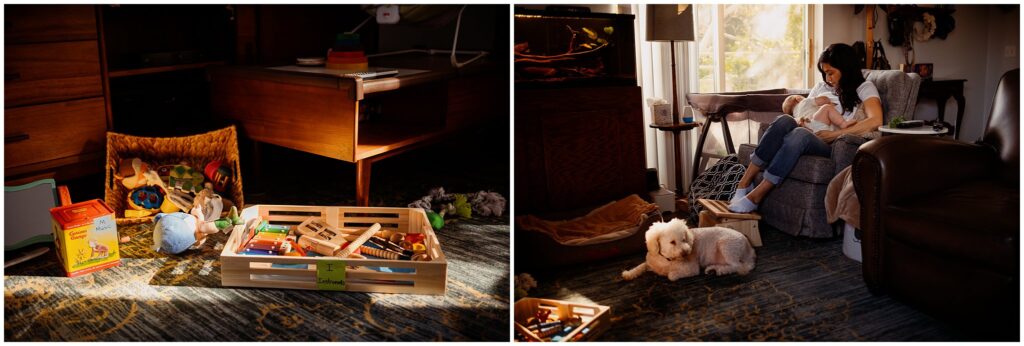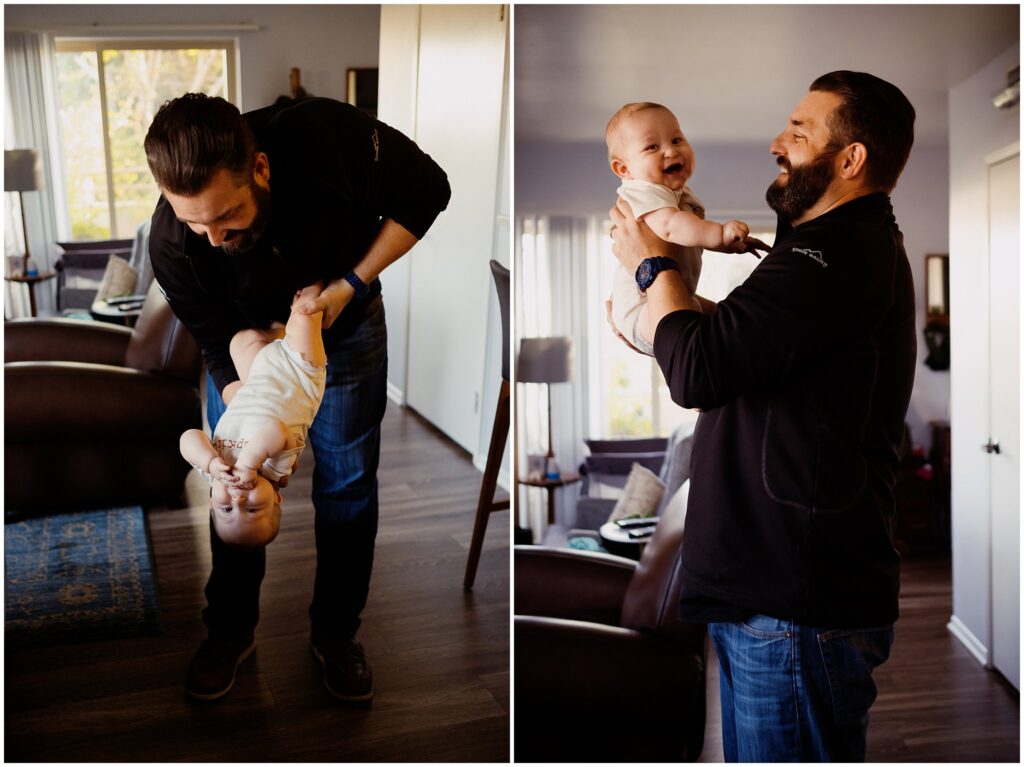Surviving our Crazy Postpartum C-Section Experience – “I Wish I Knew…” Episode 05

newborn
family
Client tips
parent tips
"I wish I knew"
I'm Marjorie
LOS ANGELES NEWBORN & FAMILY PHOTOGRAPHER
I work with parents who want relaxed and unposed photos, providing them with images that capture the joyful and unscripted moments in life.
More about Me
In this episode of the parenthood documentary series, “I Wish I Knew,” Catherine and Eric share their unique postpartum experience of dealing with an infected c-section incision that had to be kept open for 5 weeks, and pathological engorgement of the breasts from breastfeeding.
Dealing with an infected C-section incision and pathological engorgement
Eric had to stuff Catherine’s open cesarian wound with 7 feet of gauze twice per day for 5 weeks while Catherine stood and breastfed their baby. Amazingly, their struggles brought them closer together and they were “killing it in the partnership department” for those first several weeks with a new baby.
Watch the episode for an honest and detailed account of their first weeks as new parents.

TABLE OF CONTENTS

C-Section Incision – Signs of Infection
“Fever-like symptoms and inflammation around a C-section wound could be signs of infection. Keeping the wound clean and in a sterile environment can help reduce the risk of infection.
Infections following a cesarean delivery are common. They occur in around 2-15% of all C-section surgeries.
The wound coming into contact with bacteria or other harmful microbes is a common cause of these infections. Different causes can lead to different types of infection, such as cellulitis or urinary tract infections.
Signs and symptoms to look out for include:
- abnormal swelling, redness, and pain around the wound
- clear or discolored fluid coming from the wound
- abnormal vaginal bleeding
- pain or swelling in the legs
- abdominal discomfort
These symptoms may occur with fever-like symptoms such as:
- sweating
- temperature over 100.4°F (38°C)
- headache
- chills
- loss of appetite
- dehydration
- fatigue
- muscle aches
- difficulty concentrating
Signs of infection may not show up immediately after surgery. It can take up to 30 days for symptoms to develop. If symptoms do develop, it is important to see a doctor as soon as possible for guidance on the best treatment.“
Read the full article for more information.
Source: Medical News Today

Pathological Engorgement of the Breasts
“Engorgement comes in two varieties: physiologic and pathologic. Physiologic engorgement is the normal breast fullness and enlargement that occurs with milk onset, usually around postpartum day three. The skin is tight, and the breasts feel warm, but discomfort is mild. There is minimal edema, and most importantly, milk will still flow—baby is able to transfer milk from the breast, or the parent can express milk.
With pathologic engorgement, breast enlargement is more pronounced. Skin is extremely tight, appearing taut and shiny. The breasts are painful and hot, and fever may be present. In addition to milk build-up, there is severe edema. Lumps and hard areas may be palpable. When engorgement reaches this stage, milk will not flow, and it becomes hard to drain the breast, either by nursing or expressing milk.
The key to treating engorgement is to remove milk regularly and effectively. Encourage frequent nursing, with optimal latch and positioning. If flat nipples are an issue—or if the engorgement is causing flattening of nipples—teach the parent to shape the breast using reverse-pressure softening, or try hand-expressing or pumping before feeding. NSAIDs can be used for pain and swelling. Massage can also be a helpful tool, especially when used during feedings.”
Visit the link below to read the full article.
Source: Lactation Education Resources

Second Infertility, IUI (Intrauterine Insemination,) and IVF (In-vitro Fertilization)
“After having your first child, you might think that having a second successful pregnancy will be easy. However, that’s not always true, and you are not alone.
Secondary infertility is defined as the inability to conceive or carry a baby to term after previously giving birth. And it affects millions of parents, according to the National Center for Health Statistics.
There are several factors that can contribute to secondary infertility in women and men including:
- Advanced maternal age (age 35 and older)
- Impaired sperm production or low-sperm count
- Damaged fallopian tubes
- Endometriosis
- Uterine conditions
- Polycystic ovary syndrome
- Excessive weight gain in both men and women
- Lifestyle factors including smoking and heavy alcohol use
- Certain medications
Secondary infertility — just like primary infertility — can be diagnosed as unexplained. About 1 in 5 cases of secondary infertility are identified as unexplained.
Treatments for secondary infertility are similar to those offered for primary infertility.
- Oral or injectable fertility medications, which make your ovarian follicles trigger the release of more eggs in a single reproductive cycle.
- Intrauterine insemination (IUI), during which sperm is placed inside the uterus to promote fertilization. IUI can increase the number of sperm that reach the fallopian tubes, which increases the likelihood of successful fertilization.
- In vitro fertilization (IVF), which involves combining egg and sperm outside the body.”
For more information, check out the full article at the link below.
Source: Penn Medicine

Geriatric Pregnancy
“Geriatric Pregnancy, or advanced maternal age, is a medical term to describe people who are over age 35 during pregnancy. Pregnancies have an increased risk for certain complications when the birth parent is 35 or older. Some of these complications are higher rates of miscarriage, genetic disorders, and certain pregnancy complications like high blood pressure or gestational diabetes.
Advanced maternal age pregnancy isn’t treated much differently than a typical pregnancy. Your healthcare provider may suggest prenatal testing and monitor you more closely. Being mindful of your pregnancy symptoms and staying healthy becomes even more important when you’re over age 35 because your risk for chronic conditions increases.
Despite these risks, people can have healthy pregnancies and healthy babies after 35.
Healthcare providers have discovered that the biggest decline in fertility happens in your mid-to-late 30s. A decline in fertility means the quality and quantity of eggs in your ovaries decreases. This doesn’t mean getting pregnant after 35 is impossible (it’s very possible). It means 35 is the age when fertility starts to decline more rapidly and your chances for complications increase more significantly.“
For more information, check out the full article at the link below.
Source: Cleveland Clinic

About Marjorie
Hi, I’m Marjorie. I’m a Newborn & Family Photographer based in Los Angeles, California, and the creator of this documentary series, “I Wish I Knew… A Series on Parenthood.”

Soon after I started my business and began hanging out with different families, I realized every single parent I knew had gone through something. Everyone had a story.
I decided to use my background in filmmaking to create a platform where parents could share their stories. My hope is that we can learn from each other and normalize events and experiences that have been labeled as taboo.
Sign up to receive the latest episode!
If you’re interested in staying in the loop and being among the first to watch new episodes as they are released, join the email list!
We cover topics such as mental health, pregnancy loss, adoption, divorce, out-of-hospital birth, and more.
Preparing Your Home For Your Photo Session
Easy and stress-free guide on getting your home ready for a photo session. Here’s what you need to do and here’s what you can skip!
5 Quick Tips for
grab your guide
free guide
Post Comments